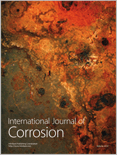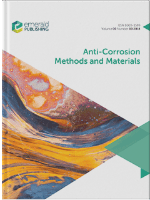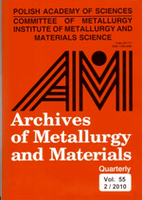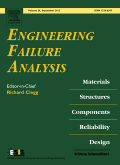
Corrosion Science and Technology-Korea
Scope & Guideline
Fostering collaboration in the realm of corrosion science.
Introduction
Aims and Scopes
- Corrosion Mechanisms and Modeling:
Research focusing on the fundamental processes and mechanisms of corrosion, including electrochemical interactions, material degradation pathways, and the development of predictive models to understand corrosion behavior under different conditions. - Corrosion Resistance Enhancements:
Studies aimed at improving the corrosion resistance of various materials through innovative coating technologies, alloy modifications, and surface treatments, ensuring longevity and durability in harsh environments. - Corrosion in Specific Environments:
Investigations into corrosion phenomena in specific environments such as seawater, acidic solutions, and high-temperature applications, including the effects of environmental factors on material integrity. - Application of Advanced Materials:
Exploration of the utilization of advanced materials, including composites and nanomaterials, for corrosion protection and the development of new corrosion-resistant alloys tailored to specific applications. - Corrosion Monitoring and Assessment Techniques:
Development and application of various techniques for monitoring corrosion processes, assessing material conditions, and predicting corrosion-related failures in industrial settings.
Trending and Emerging
- Nanotechnology in Corrosion Protection:
The integration of nanomaterials and coatings for enhanced corrosion resistance is gaining traction, showcasing the potential for improved performance and functionality in various applications. - Artificial Intelligence and Machine Learning Applications:
Research utilizing AI and machine learning techniques to predict corrosion behavior, optimize coatings, and analyze corrosion data is on the rise, indicating a trend towards data-driven approaches in corrosion science. - Sustainable and Green Corrosion Inhibitors:
There is an increasing focus on environmentally friendly corrosion inhibitors derived from natural sources, aligning with global sustainability goals and reducing the reliance on harmful chemicals. - Corrosion in Renewable Energy Technologies:
With the growth of renewable energy sources, studies addressing corrosion challenges in solar panels, wind turbines, and energy storage systems are emerging, highlighting the importance of material durability in these sectors. - Advanced Coating Technologies:
Research into innovative coating technologies, including multifunctional and self-healing coatings, is expanding, reflecting the demand for advanced solutions to combat corrosion in critical infrastructure.
Declining or Waning
- Traditional Corrosion Inhibition Methods:
Research on conventional corrosion inhibitors, particularly organic compounds, has become less prevalent as newer, more environmentally friendly, and effective materials are being developed and studied. - Corrosion Studies with Limited Application Contexts:
Papers focusing solely on corrosion in niche or less relevant applications, such as certain legacy materials or outdated technologies, have seen a decrease, as researchers shift towards more applicable and impactful studies. - Basic Corrosion Testing Procedures:
Standardized laboratory tests that do not incorporate advanced techniques or real-world applicability are becoming less common, as the focus shifts towards more complex and realistic testing scenarios that better simulate actual service conditions.
Similar Journals

International Journal of Corrosion
Leading the Charge Against Corrosion in EngineeringInternational Journal of Corrosion is a distinguished peer-reviewed journal published by HINDAWI LTD, focusing on the critical field of corrosion research, a vital aspect of materials science and chemical engineering. Since becoming an Open Access journal in 2010, it has provided a platform for disseminating pivotal findings related to corrosion mechanisms, prevention strategies, and innovative materials designed to counteract corrosion, thus directly impacting industries ranging from construction to energy. The journal boasts a respectable impact reflected in its Scopus rankings, holding a Q3 quartile in both Materials Science and Process Chemistry and Technology, with commendable rankings of #157 out of 463 and #37 out of 73, respectively. By fostering knowledge exchange and collaboration among researchers, professionals, and students, the International Journal of Corrosion plays an essential role in advancing the understanding of corrosion phenomena, thereby contributing significantly to the development of more resilient materials and sustainable engineering practices.

ANTI-CORROSION METHODS AND MATERIALS
Exploring Advanced Materials for Lasting ProtectionANTI-CORROSION METHODS AND MATERIALS, published by EMERALD GROUP PUBLISHING LTD, is a leading journal in the fields of chemical engineering and materials science, focusing on innovative methods and materials for corrosion prevention and control. With its ISSN 0003-5599 and E-ISSN 1758-4221, this esteemed journal has been contributing to the academic community since its inception in 1954 and continues to be relevant through 2024. Despite its Q3 ranking in both Chemical Engineering and Materials Science categories, the journal plays a critical role in disseminating valuable insights and advancements, catering to a diverse audience of researchers, professionals, and students. Although the journal does not offer open access options, it remains a significant resource for those seeking to enhance their understanding of corrosion methodologies and to implement best practices in various industrial applications. With the recent Scopus rankings reflecting its impact, ANTI-CORROSION METHODS AND MATERIALS stands as a pivotal element of scholarly discourse in mitigating corrosion challenges in modern materials.

ARCHIVES OF METALLURGY AND MATERIALS
Fostering Collaboration in the Materials Science CommunityArchives of Metallurgy and Materials is a prestigious open-access journal published by the Polish Academy of Sciences, Institute of Metallurgy and Materials Science. With its ISSN 1733-3490 and E-ISSN 2300-1909, this journal has been a critical resource for researchers and professionals in the field of materials science since its establishment in 2004. The journal focuses primarily on advancements in metals and alloys, contributing to the growing body of knowledge in this dynamic and evolving discipline. As acknowledged in the 2023 Scopus rankings, it currently holds a Q3 category in both Metals and Alloys with a rank of #117 out of 176 journals, indicating its commitment to quality research despite being relatively young in the indexing landscape. With its open-access policy initiated in 2010, the journal aims to enhance the dissemination of scientific findings and encourage collaboration among the global materials science community. Researchers, students, and industry professionals are invited to explore the valuable insights and innovations showcased within Archives of Metallurgy and Materials, contributing to the advancement of material technologies and applications.

CORROSION
Exploring Corrosion Phenomena Across IndustriesCORROSION is a prestigious journal published by the Natal Association of Corrosion Engineers, dedicated to advancing the understanding of corrosion phenomena in various materials across multiple industries. With a strong commitment to high-quality research, it has established itself as a key resource in the fields of Chemical Engineering, Chemistry, and Materials Science, as reflected in its Q3 ranking in the 2023 category quartiles. This journal, retaining its relevance since 1969, serves as a platform for innovative studies and findings that address fundamental and applied aspects of corrosion, vital for professionals engaged in material selection and integrity management. Through access to state-of-the-art research, CORROSION significantly contributes to the safety, sustainability, and efficiency of engineering practices worldwide. Researchers, professionals, and students alike can benefit from the insights offered by this journal, driving forward the quest for innovative solutions in corrosion management.

CORROSION SCIENCE
Exploring the depths of chemical and material resilience.CORROSION SCIENCE, published by Pergamon-Elsevier Science Ltd, is a leading journal in the field of corrosion research, recognized for its significant contribution to advancing knowledge in Chemical Engineering, Chemistry, and Materials Science.
With a remarkable impact factor placing it in the Q1 category as of 2023, this journal serves as a crucial platform for researchers, engineers, and practitioners dedicated to the study of corrosion processes, prevention methods, and material degradation. Since its inception in 1961, CORROSION SCIENCE has consistently provided high-quality peer-reviewed articles that explore innovative solutions to corrosion-related challenges, fostering advancements not only in academic research but also in practical applications across various industries. The journal is based in the United Kingdom and is accessible through various academic databases, making it a vital resource for students and professionals seeking to enhance their understanding of corrosion mechanisms and mitigation strategies.

Journal of Coatings Technology and Research
Innovating Surfaces, Transforming IndustriesThe Journal of Coatings Technology and Research, published by Springer, stands as a vital resource for researchers and professionals in the fields of materials science and chemistry. With an ISSN of 1547-0091 and an E-ISSN of 1935-3804, this journal is recognized for its significant contributions to the study of coatings technology, encompassing diverse aspects from surfaces and interfaces to colloids and surface chemistry. Currently holding a 2023 Impact Factor that places it in the Q2 and Q3 quartiles across several categories—including Chemistry and Colloid and Surface Chemistry—the journal serves as an essential platform for disseminating innovative research. Its accessibility options cater to a broad audience, ensuring that both established scholars and emerging researchers can engage with the latest findings. Since its inception in 2004, the journal has continued to foster advancements in coatings technologies, promoting sustainable practices and novel applications across industries.

Engineering Failure Analysis
Decoding Failures to Enhance Engineering ReliabilityEngineering Failure Analysis is a prestigious peer-reviewed journal published by PERGAMON-ELSEVIER SCIENCE LTD, dedicated to advancing the field of engineering through comprehensive investigations into the causes and consequences of failures in various engineering domains. Established in 1994, the journal has become a cornerstone of knowledge in sectors such as Aerospace, Automotive, and Materials Science, earning its place within the Q1 quartile across multiple relevant categories in 2023. With a broad scope that encompasses topics related to safety, risk, reliability, and quality, it serves as a vital resource for researchers, professionals, and students keen on understanding how to mitigate failures and improve engineering practices. Although this journal does not currently offer Open Access, its impact is underscored by its high Scopus ranking, where it sits comfortably in the 36th position out of 307 in General Engineering. By bridging theoretical insights and practical applications, Engineering Failure Analysis plays a pivotal role in shaping the future of engineering standards and safety practices.

SURFACE AND INTERFACE ANALYSIS
Transforming Knowledge on Surfaces and InterfacesSURFACE AND INTERFACE ANALYSIS, published by WILEY in the United Kingdom, is a renowned journal specializing in the examination of nanoscale phenomena and the properties of surfaces and interfaces across various materials. With a focus on advancing the fields of Chemistry, Condensed Matter Physics, and Materials Science, this journal has established itself as a critical resource since its inception in 1979, bridging over four decades of scientific discourse. Notably, it holds a commendable position in the Scopus rankings, emerging in the 2023 Q3 quartile across multiple categories, including Chemistry (miscellaneous) and Surfaces, Coatings, and Films. Although it does not currently offer Open Access, SURFACE AND INTERFACE ANALYSIS remains pivotal in disseminating high-quality research, providing an essential platform for academic scholars, industry professionals, and students aiming to deepen their understanding of surface phenomena and material characteristics. Its comprehensive coverage of innovative methodologies, experimental results, and theoretical insights reaffirm its significance in the scientific community.

RARE METAL MATERIALS AND ENGINEERING
Advancing Innovations in Rare Metal EngineeringRARE METAL MATERIALS AND ENGINEERING is a vital academic journal dedicated to advancing the fields of materials science, engineering, and metallurgy. Published by the NORTHWEST INST NONFERROUS METAL RESEARCH in China, this journal has been an essential resource for researchers and professionals since its inception in 1993. With a focus on rare metals and their engineering applications, the journal addresses contemporary issues and innovations in materials chemistry and electronic engineering, providing insights into the properties and uses of advanced materials. Although it currently falls within the Q4 category for several categories, including Electrical and Electronic Engineering and Materials Chemistry, its commitment to quality and relevance in the field is evident. The journal offers a platform for researchers to share their findings with the scientific community, fostering collaboration and knowledge exchange in an important area of study. Researchers and students interested in exploring the latest in rare metal technologies and engineering methodologies will find this journal a valuable addition to their academic library.

MATERIALS AND CORROSION-WERKSTOFFE UND KORROSION
Fostering Knowledge in Corrosion ManagementMATERIALS AND CORROSION-WERKSTOFFE UND KORROSION, published by WILEY-V C H VERLAG GMBH, stands as a pivotal resource in the fields of materials science and engineering. Established in 1950, this peer-reviewed journal publishes innovative research that advances our understanding of materials performance and degradation in various environments. With a commendable impact factor and notable rankings in several categories—including Q2 in Materials Chemistry and Mechanical Engineering—the journal attracts submissions from leading researchers worldwide. It encompasses a diverse range of topics related to metals, alloys, surfaces, coatings, and environmental impacts, thereby serving a broad audience of scholars and professionals. The journal offers both subscription and Open Access options, ensuring that significant research findings are readily available to all. With its commitment to fostering knowledge and collaboration, MATERIALS AND CORROSION plays a crucial role in addressing the evolving challenges in material science and corrosion management.